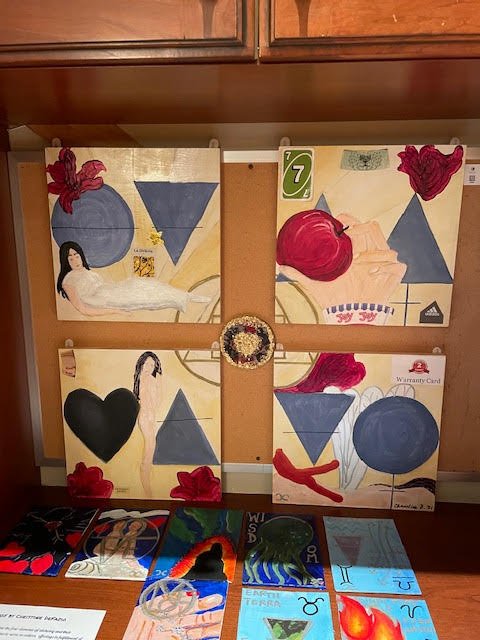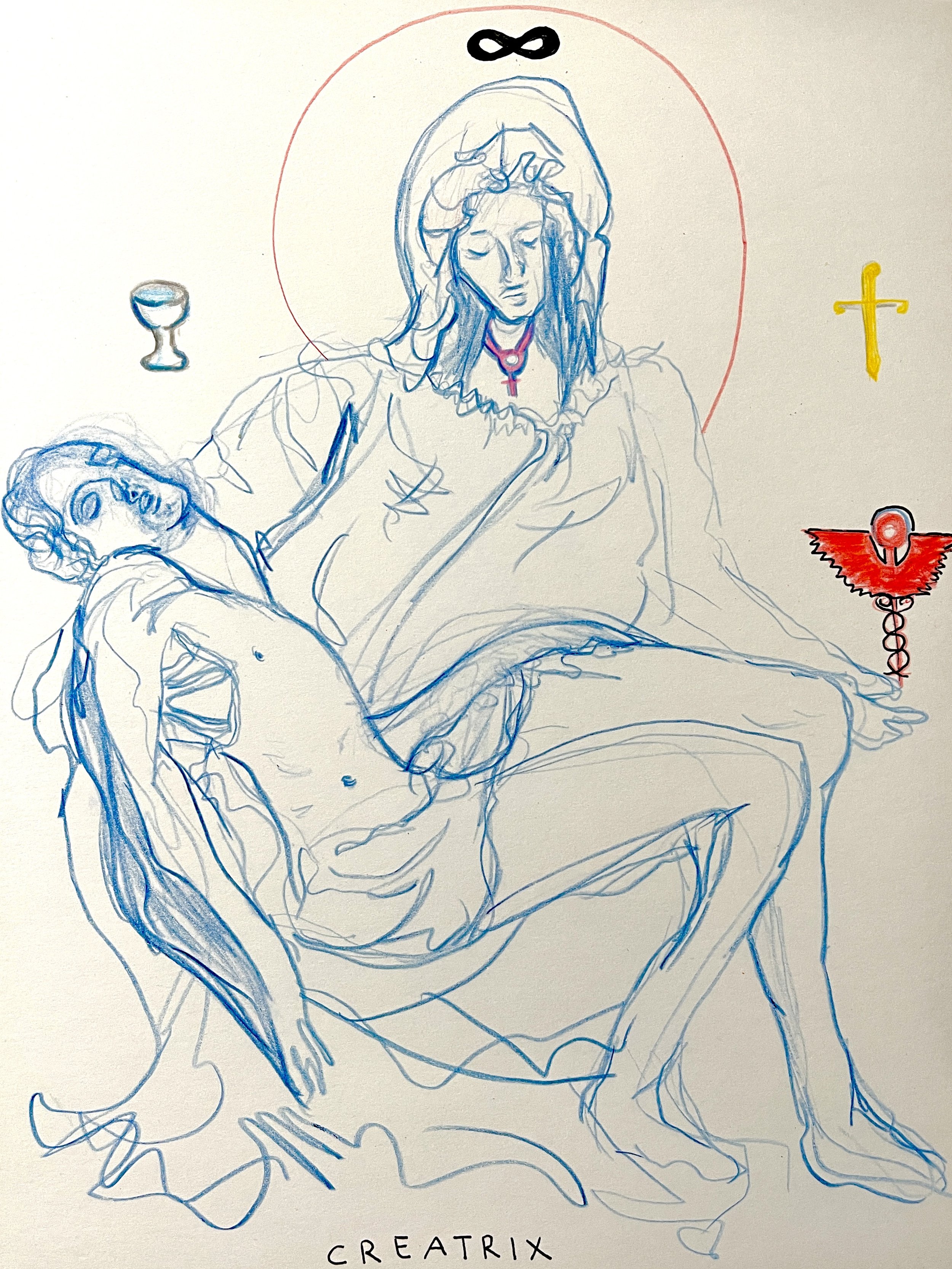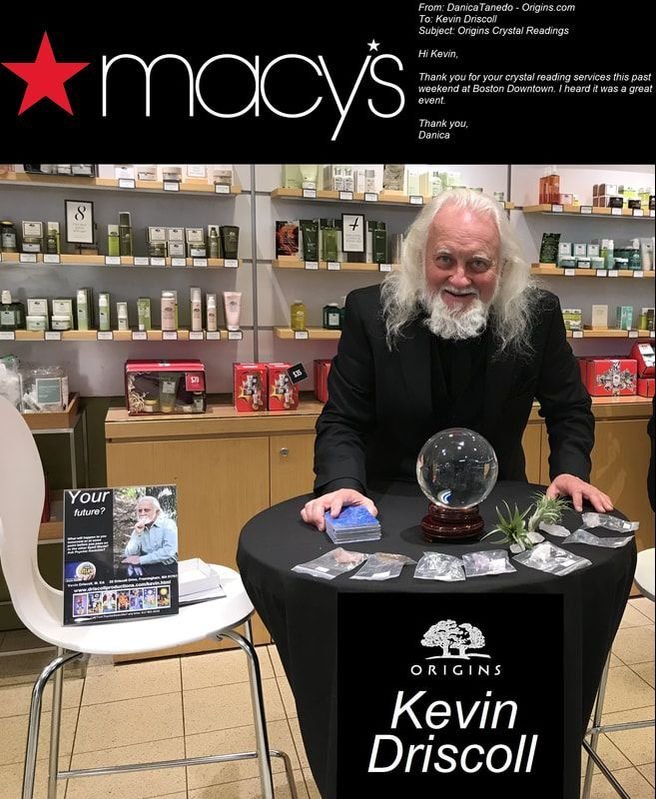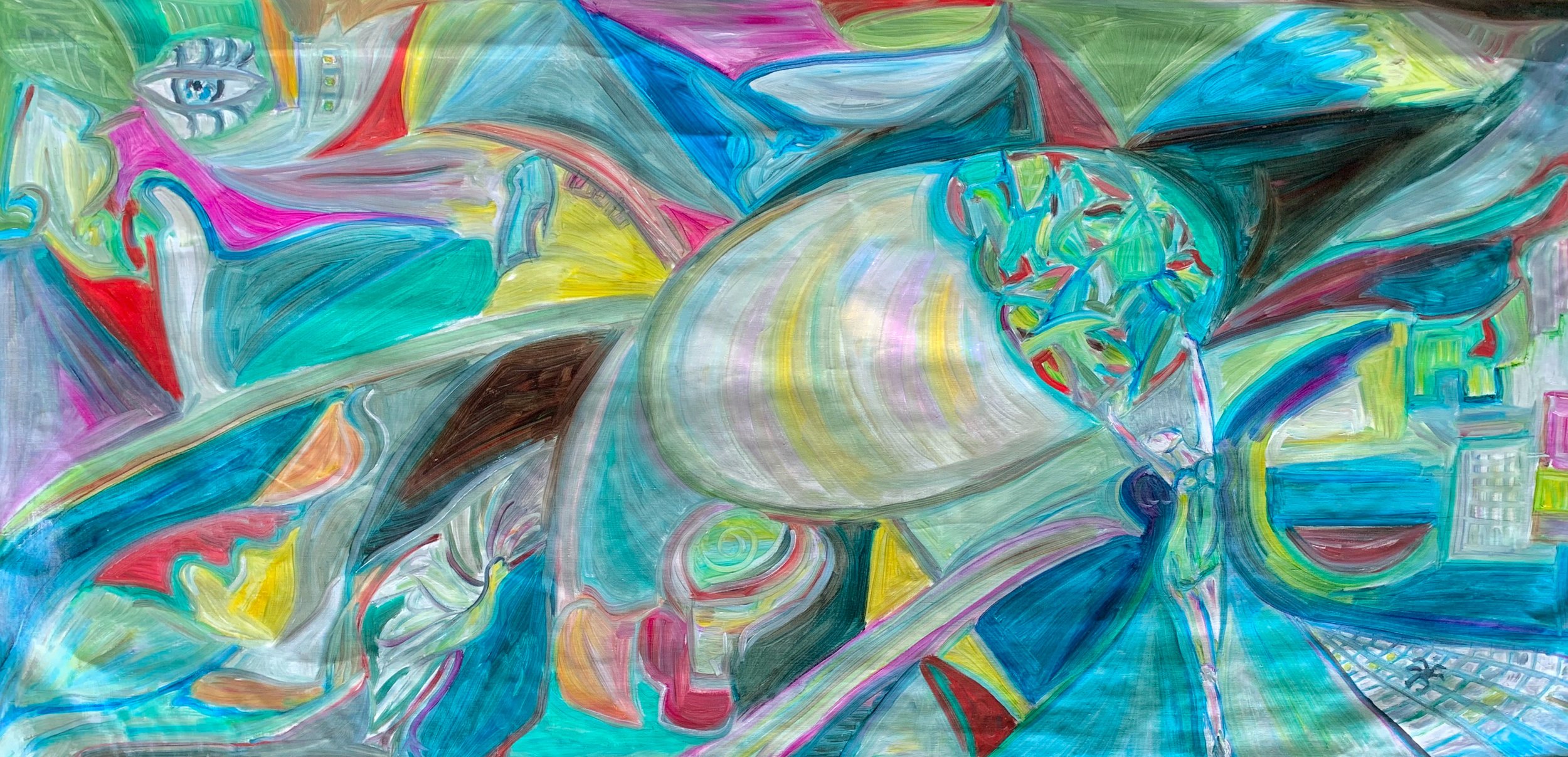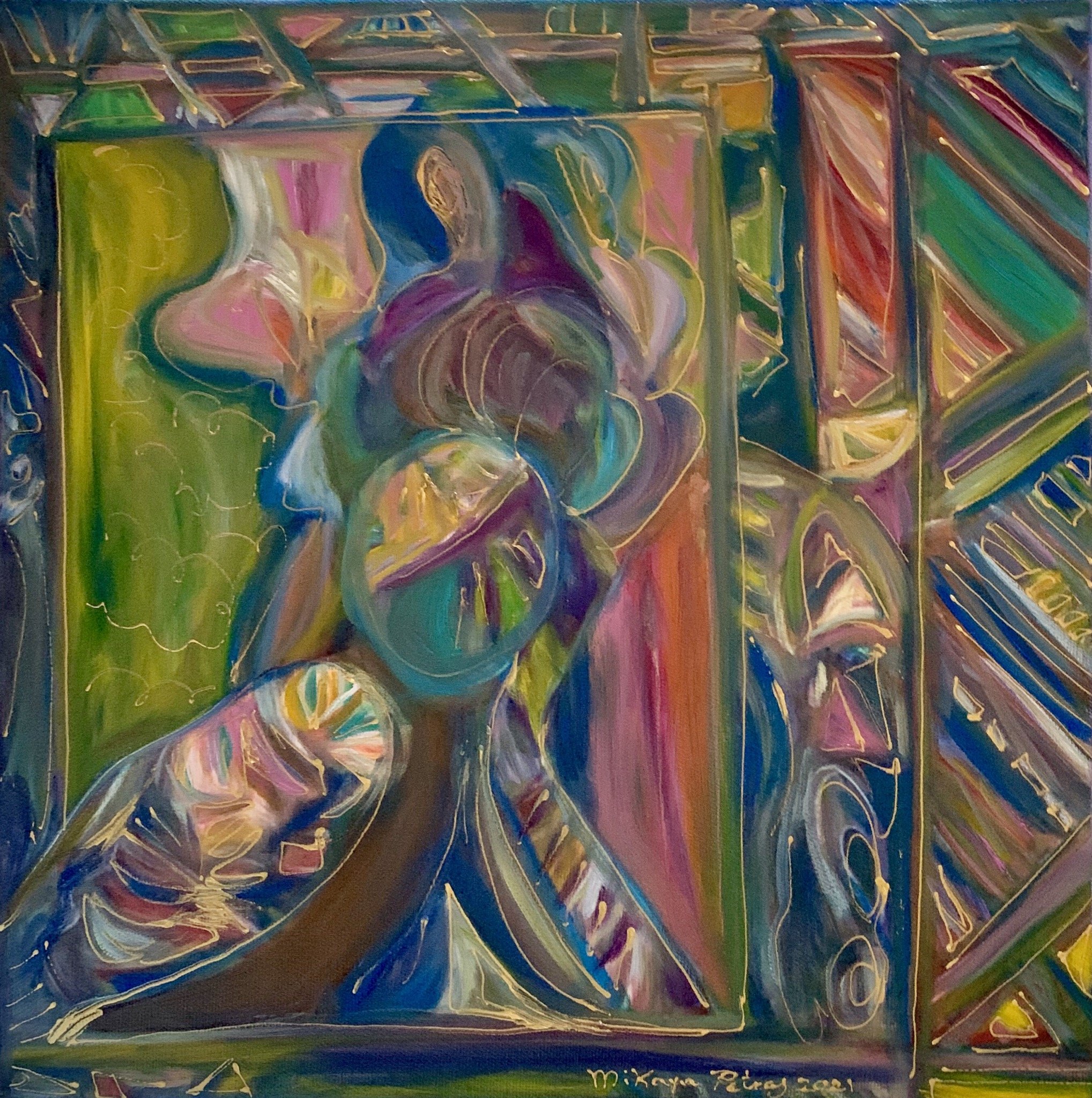This video includes subtitles.
Opening Practice Invitation: Somatic Anchor
Chloe Fox-Edele
My work is inspired by life experiences with a focus on identity: themes of internal struggles, self-exploration, social deviance, and intimacy and vulnerability. The images I create are represented in the mediums of painting, illustration, photography, and video. I am driven by a cinematic and scrapbook diary aesthetic: a juxtaposition of both sophistication and ‘grunge’. I strive to effectively communicate my ideas through relatable and emotionally provoking images influenced by a desire to question social hierarchies, injustices, and norms.
Christine DeFazio
Christine DeFazio is an art educator and artist working in the Bronx focusing on Urban Arts. Her Pop Art artwork focuses on capturing the psyche of her sitters, often caught in a dilemma expressed through allegory or myth with a touch of Surrealism. She aims to convey stories of love, longing and despair, through her imagery of the female form. She just recently participated in a Conceptual Art performance based group exhibition at the School of Visual Arts, creating a series based on the theme of Black Hearts and Rotten Apples, which inspired the series, The Alchemy of Emotions. Other series she is working on examine the culture of urban youth in the South Bronx; American Kultur, with social commentary on American culture; and Glam, based on the music and culture of the late 70’s and early 80’s. You may view her artwork on her Instagram. She has recently shown at Van Der Plaz Gallery and Brooklyn Art Cave. Her work is featured on artland.com.
What’s Your Candy?
This piece was influenced by the 80’s song I Want Candy by Bow Wow Wow. The symbols reference repression and luck in love. It is part of a series inspired by 80’s Glam music and culture. She is fed a diamond with silver chop sticks. Life is a gamble under neon palm trees. Holding the ace of hearts, one in 52, who will outwit, out talk, seduce, followed by the two of hearts, love and passion found, the King of hearts is passionate, amorous, hasty to love, the Queen of hearts represents intuition, leading to 10 of hearts, love in all aspects of life and 7 of hearts, new opportunities.
Rotten Apples and Black Hearts
This piece incorporates the four alchemical elements, water, earth, air, and fire with emotions derived from personal experiences and stories derived from social media. In the first panel, Black Hearts, a beautiful woman looks at herself critically, thinking “Who would want my black heart?” In the second, La Delizia, a woman waits for love. In the third, Rotten Apples, a woman is offered an apple, a sincere gesture and an allegory for the fall of man. In the final panel, Star Light, Star Bright, a fairy symbolizes rebirth, after the turmoil we experience on the road to love. In the center of the four panels is the symbol for the philosopher’s stone which alchemists thought would turn base metals into gold, an equivalent for the cycle of romance.
Ciarrai Strong
Born in Miami to immigrant Colombian Parents, Ciarrai Strong is a multidisciplinary artist and warrior against imperialism. At eighteen they fled a strict and religious upbringing for NYC, infiltrating the lower east side’s creative circles to form the performance art band Your Boyfriend’s Band Sux! The all female band was an intersection of POC feminism and the birth of an unapologetic queer awakening. After years of struggling with undiagnosed mental illness, they left normative work life to explore Brooklyn’s art scene as the singer, designer and producer for their solo project GLuuuu.
Simultaneously, they would enroll at The City College of New York to study Latin American Literature, photography, Psychology of Religion and Astronomy with theoretical physicist Michio Kaku. During their 3rd year they were awarded the Colin Powell Community Service Fellowship for non-profit work as Project Coordinator for the diversity initiative YouthBridge-NY. Here, they organized multimedia strategies that raised social awareness and a spirit of service in high school students from marginalized communities. Today Ciarrai lives in San Francisco, staving off quarantine by studying ancestral herbalism and quietly making art for time capsules as archives of the human experience.
Creatrix
Humberto Guanipa
My work stems from early memories and first impressions. Relating to our physical evidence and emotional baggage we all carry. The work arises from my subconscious, the process in which I create is both intuitive and spontaneous. There are no preconceived notions. Everything is symbolic: the past, the present, and the future. Freedom belongs to everyone, to the ones on top, those at the bottom, and those that we dispose of. There will always be a division between those who fear reality and those who construct it: and I construct it. I am ultimately a visual poet who transcends the picture and orchestrates a complete performance, a symphony of color and shape that allows the viewer to participate in, bringing their experiences into their Homeric Spaces.
The Moon
The Moon Statement
J Nguyen
I had the honor to be a part of the SEAD Project’s SEA Change Lab (SCL) cohort this fall and have met so many beautifully resilient and talented Southeast Asian artists. I can gush about the cohort experience for hours, but cannot express the eternal gratitude I feel for my cohort members and their vulnerability and trust in sharing their artistry. The cohort culminated in a community recital where we shared our projects that we’d worked on throughout the cohort, guided by thematic issues diasporic SEA folks experience. Please go check out SEAD’s Facebook page for the archived livestream of the recital! Here’s my project- shared here with breadth. It was brought forth from my discomfort and curiosity around what it means to be queer and connected with your ancestors. I had fears about coming out to my mom and her partner and them rejecting me. This may very well be the reality, but my fears were made worse when I thought about the topic of ancestry, common in diasporic spaces. I struggled to engage in these conversations because I felt like my ancestors wouldn’t have understood what it meant to be nonbinary and therefore wouldn’t love me. This project explores the remedies through reflection and space-making for disconnection that I practiced.
I built an altar that was inspired by the altars I had in my homes growing up. One of the many beauties of altars and space making is that it can literally be what you need it to be. If something feeds your soul, add it to your altar. If something no longer serves you, remove it. I had initially felt obligated to stick to tradition and have all the components of the altar I had seen growing up in a Vietnamese Buddhist household (also because I was lowkey scared that if I physically manipulated/modified anything, I could end up cursing myself), but I went ahead and made it my own because to be queer is to create. Creating space, relationships, community, self, This experience of creating my own queer little baby altar was affirming and restorative.
The following artwork includes themes of transphobia and family acceptance.
Jeanine Malec
Nest and Tessellate explores magical symbols, pattern language and seasonal crafts derived from traditional folk arts. My practice seeks to connect with ancestral art forms, reimagine folk charms and build relationships within community around these interests. Symbols charged with intention have been used for millennia as agents of healing and protection on textiles, buildings and household tools. Gathering precedents from around the Midwest and beyond; I hope to draw parallels between diverse sources, identify shared meanings and with help from collaborators, develop new visual lexicons reflective of current needs. The goal is to create a magical folk art for our time.
As a Hexologist, a lot of my energy goes into researching context and raising awareness of the traditional folk charms in our midst. Growing up, my Scandinavian, Irish and Croatian heritage taught me to love my landscape along the St. Croix River valley. Acknowledging that this land was taken forcefully from the Dakota people and as a survivor of trauma and CPTSD myself, this is very much a healing arts practice. Re-orienting toward cultural roots and grounding in seasonal cycles, I work on ceramic, wood and copper surfaces with a preference for re-used and locally sourced material whenever possible.
Folk art is born out of lived experience within natural settings. Specific adaptations to local conditions give rise to unique forms of creative expression that are responsive to place. Against a backdrop of stars, regional biodiversity is the kernel on which human culture has been coded. The oldest known form of magic, pictographs that adorn the earliest human artifacts are known to have been designed to grant agency in the world by appealing to natural forces. In the present era, it is the collective consciousness of humanity that is called upon to restore wholeness to our living biosphere.
Today, traditional folk arts are often separated from their intended purposes, robbing them of power. We categorize material culture into orderly systems of taxonomy, mothballing folklore in an effort to preserve it. We need the context that living folk practices provide to focus our energies on present climate challenges and honor place as our ancestors knew to in their folkways. Contemporary folk arts can help re-grow connective tissues to mobilize community around the great work of healing social wounds and protecting ecosystems - multiplying our efforts through synergy.
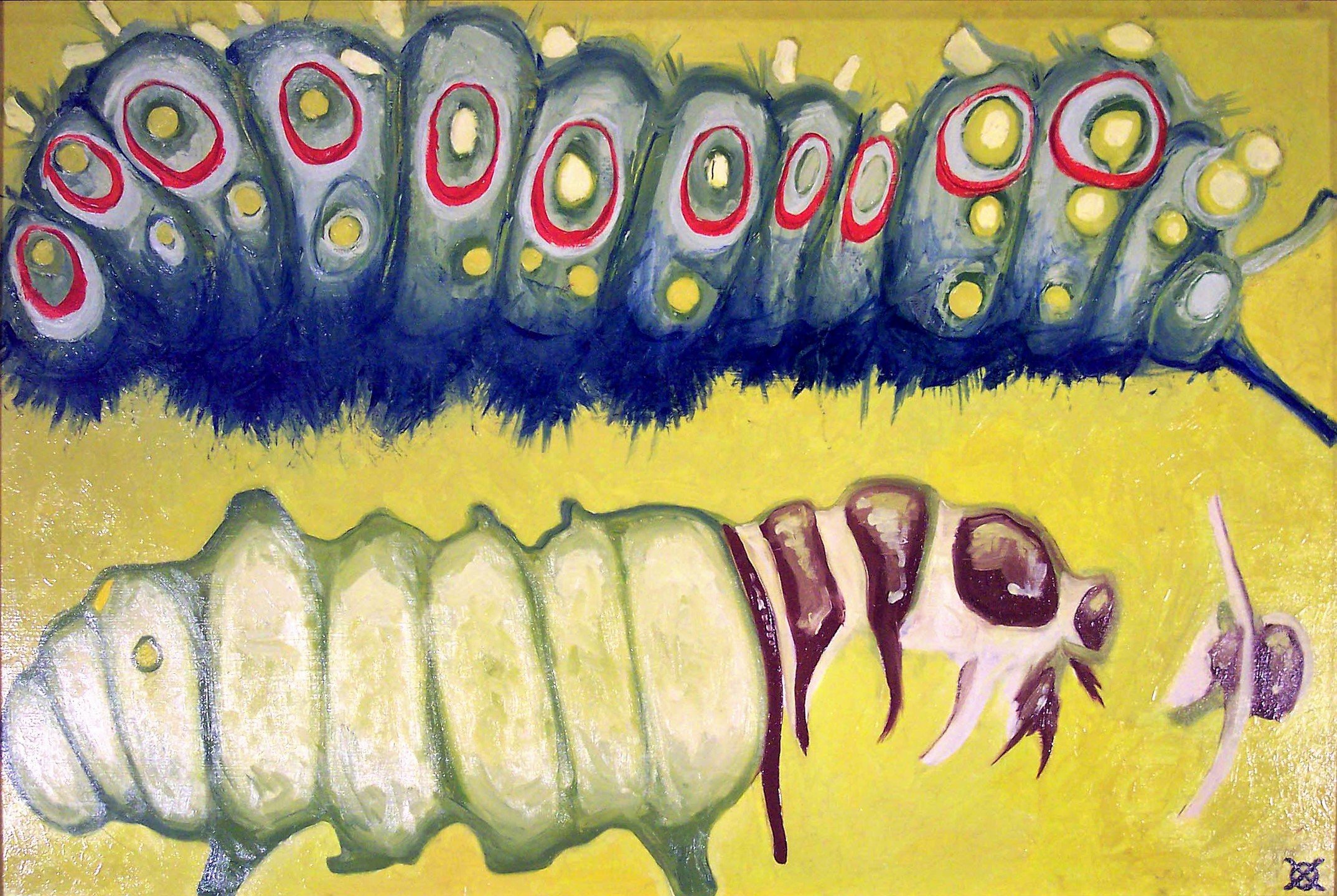
2 of Wands

3 of Wands
Jennifer Weigel
This work is an evolution wherein I started with a base image of a holiday decoration tree of lights that radiated into a starfield and then morphed into the Star Tarot. The Star is a card of hope and faith and blessing.
I didn’t always feel so lucky. My past has not always been light despite the fact that from the outside I didn’t seem to want for anything. I was relentlessly picked on, sexually harassed and assaulted by my peers. Children can be very cruel to one another despite so many adults wanting to see them as innocents.
But, even after my own personal journey into darkness, struggling with anxiety, depression and an eating disorder, I am very grateful to finally find stability and solace even if I still struggle from time to time. I try to focus on the blessings. I make art as a means of creating shared experiences and conversations, to heal, and to reconsider what is truly beautiful both inside and out.
Jose Trejo Maya
I am a remnant of the Nahuatlacah oral tradition a tonalpouhque mexica, a commoner from the lowlands (i.e. Mexico) from a time and place that no longer exists. At present my poetry has been reified as it has been published in the UK, US, India, Spain, Australia, Argentina, Germany and Venezuela. I have been exhibited in different venues with a work that’s titled: Transparencies in Time: Cuahpohualli embedded in ethnopoetic language poetry:. I seek to expand on this work into a comprehensive exhibit in a gallery in 3D (i.e. three simultaneous exhibitions that expand into multiple levels of perception and/or dimensions).
I was born in Celaya, Guanajuato, Mexico, where I spent my childhood in the small neighboring rural pueblo of Tarimoró and wherefrom my family immigrated in 1988. My inspiration(s) include Netzahualcoyotl, Humberto Ak’abal, Ray A. Young Bear, and James Welch.
I have a work in progress of a short-story series were I interpolate the sunstone calendar (i.e. the primary source of the Cauhpohualli Computo del tiempo azteca y su correlacion actual Anahuacayotl de Tlaxcalancingo, Puebla); to bring to life a micro-fiction project titled San Miguel de Tarimoro ca. 1546. It’s a micro-fiction work of short stories that delve into the immaterial aspects of time. It will be digitized into video with simultaneous audio in video-book view narration. Namely, it’s a bridge from poetry to narrative storytelling. The work is a catalog of the 365 days in the Tonalpohualli or count of days in hologram. My work is rooted in Mesoamerican lore and a pre-Columbian notion of time that’s extant in the poetics and as such it’s the foundation and bedrock. While in ceremony with Chololo medicine men in the Tule River Reservation he dreamt this written prophecy…
Mikaya Petros
Perhaps it is superfluous to say that for me Art is not only a primary need, it has always been my way of living, breathing and looking at things. My father, a surrealist painter, has certainly been my Master of Art and Life. I remember when I was just 4 years old, he would lift me in his arms to read the landscape pictorially with me. "There you put the whites, in those shadows you put the colors all together, because black does not exist being the mix of colors that inhabit your brush." This is a necessary premise to understand my painting and my propensity to stop on paper all the things that I have an urgent and unstoppable need to say, almost under dictation, almost as if I did not have the time to communicate everything. My relationship with paper also has deep roots because Petros had a printing press where some of the catalogs and posters that have made the history of part of our contemporary art were printed. Magritte, de Chirico, Andy Warhol, but the list could be long. With the remnants of printing, colored papers, long strips of scraps, I built the foundations of my artistic world, made not only of shapes, ideas, projects, but also and above all of spaces, lights and smells. The scent of raw paper, the consistency of Japanese paper against the light or in my hands, are inspirations that were difficult for me to decipher then, but certainly very clear today.
Spiritual Nomade Multimedia Artwork
Enteleky
Female Polichromatic Soul
Morrigan Chadain
As an Irish born writer and artist, my work is heavily inspired by ideas of fantasy, isolation and the movement of feminism concerning the rise of the 4th industrial woman and her place in society.
My work focuses mixing old crafts with new forms of art.
This new age of social revolution and technological growth sparks a new movement for creation. As culture and society begin to embrace the 'other' and technology, new and exciting ways to express ourselves begin to emerge.
My ideas are expressed through a mixture of Art, Technology, Poetry and Poetic Coding through the lens of Meta-Modernism, Queer identity and feminism. Having experienced poverty, classism and isolation in my youth, I wish to connect similar experiences through art and discussion.
I use hyperfeminine imagery to dissect and challenge hegemonic portrayals of expression and disdain of femininity found in the past and present. To look beyond the surface and encourage people to actually look and not mindlessly consume media. In this age of fast media consumption, I believe this to be more important than ever.
To reflect these fluid and ever-changing concepts, I work primarily on poetry, watercolour, ink and wood. For me, these ideas are multifaced and powerful, adding dimension to my work, with bright vibrant colours, double imaging and sapphic perception.
I have previously published with Green Carnations, a queer poet anthology and exhibited work in Marseille Pride 2021 and China's Shangyuan MoMa.
The following poem contains themes of death and grief. For accessibility, you can download a PDF copy here.
Pippa Martins
I am a poet, visual artist and designer. At one point in my journey of recovery from childhood abuse, I felt drawn to use the tarot as a tool for self-knowledge and healing. The cards can offer guidance, insights or reassurance, and occasionally plant the seed for some of my creative work, such as the poem and collage I present here.
For accessibility, the following poem can be downloaded as a PDF here.
Page 1 of 2.Page 2 of 2. Scarlett Shiloh
I am a watercolor artist who specializes in florals. Last year, as a result of COVID and other factors, I found myself retraumatized while reliving memories from my childhood abuse. To get through all of the pain I was experiencing, I taught myself drawing and watercolors, which is one of my newfound passions. I drew two tarot cards that spoke to me with my trauma: The Tower and the Four of Cups.
The Tower represents a crumpling of foundations where everything comes crashing down. In this picture, a vase is tipped over as the water and bouquet falls onto the floor. However, the bouquet is already in the process of decaying – there are only a few flowers and leaves, and what’s there is dying and crumbling. I find this speaks about my adult relationships and coping skills. The coping skills I learned from my childhood abuse may have gotten me through the moment back then, however these same coping skills damage my current relationships. This past year I realized why I do these things and what I can do differently. While the foundation of my relationship skills fell apart, just like the vase, it means I can get a new vase and new flowers.
The other tarot card is the Four of Cups, which also speaks about love after trauma. When I was sexually assaulted as a child, I fell in love with my assaulter. It was the first time I ever felt what being in love was like, and being in love with my assaulter gave me lots of twisted ideas of what love is supposed to feel like. To me, love felt more like obsession, and was always overshadowed by the fear of getting hurt. The three cups on the floor represent broken hearts, and while the person is being offered a new chance for love, they don’t want to take it at risk of being hurt again.
Thank you for looking at my art. I hope you enjoyed it.
Zita Vilutyte
“This is the moment of time where many finding themselves now, for to retrieving their personal power and clarity about where they desire to go next. The very nature of this time requires that one must look beyond the status qua dely the limits of ‘the box’ and possible risk failure.
This is why the deleting of boundaries are so important now, each one of us should make the right decisions that will be aligned with our authentic soul path. Therefore, it is at this time when we most see the desperate efforts of many, as well as the speed in which they try to fulfill their intents, to regain control by using extreme tactics. In the world which now in real is deemed a failure and a disastrous social experiment the social ideals, utopian societies have ultimately becoming part of it . Finally something is starting resonate with us - maybe it is a kind of a new humanism that pulls the little local life which with time will become a part of big one.”
Antahkarana ("the inner cause")


